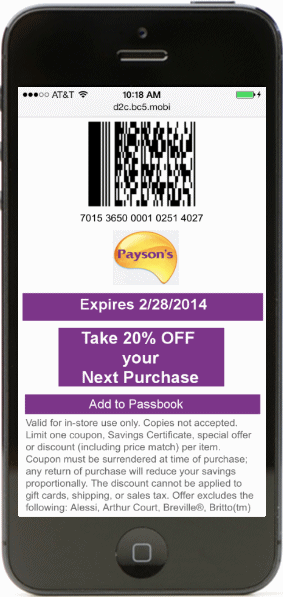Mobile Coupons are Proven to Drive Traffic to Retail Locations
Written by: Sue LeClaire
There are many different classes of mobile coupons retailers can deliver to their customers. Two of the more common types are on-demand and push.
- On-demand – a consumer responds to a call-to-action by texting in to a retailer’s shortcode to receive a mobile coupon.
- Push – the retailer delivers a mobile coupon to customers subscribed to a marketing list.

Based on years of experience working with some of the largest retailers in the US and Canada, our retailer customers routinely drive traffic to retail locations, typically realizing between 30 – 50% redemption rates for on-demand mobile coupons and up to 10% for push coupons. While 10% doesn’t seem like a high rate of return compared to on-demand coupons, it dwarfs redemption rates for paper coupons that range between .5 – 2%.
So, why are on-demand coupons so effective? Our customers have found that the answer is typically dependent on three factors: the amount of resources they expend advertising the offer, the value of the offer, and the amount of effort required on the consumer’s part to retrieve the offer.
CodeBroker retailer customers that have had the most success with on-demand mobile coupons advertise everywhere – print, online and in-store. They even enlist sales staff to encourage customers to sign-up for a loyalty program or text-in to the retailer’s shortcode to receive a mobile coupon. If the goal is to drive traffic to retail locations, the coupon is good for in-store purchases only. Otherwise, the unique coupon code should be able to be used for either an in-store or online purchase.
It’s no secret the more generous the offer, the more likely consumers will request it (e.g., $10 off your next purchase of $50 or more). The key to delivering rich offers to your customers is the ability to limit liability. One-time-use mobile coupons ensure a consumer receives and redeems only one coupon. Otherwise, retailers risk negatively impacting the bottom line by allowing a customer to redeem an offer multiple times and a poor customer purchase experience should they be denied redemption by a sales associate. Single-use coupons can be deployed for both on-demand and push offers.
Finally, if a consumer is going to expend the effort to obtain a mobile coupon, there’s a high probability they will use it. One of our retailer customers actually pitted on-demand and push mobile coupons against one another in an A/B test. A high-value offer was delivered to customers who previously registered for the retailer’s marketing list. Consumers who responded to a call-to-action to sign-up for the retailer’s loyalty program, received the same offer. The call-to-action was advertised both online and in-store. The results were in line with customer averages as a whole, 8% of customers on the marketing list redeemed the mobile coupon whereas almost 46% of customers that signed up for the loyalty program redeemed the mobile coupon proving that on-demand offers drive traffic to retail locations.
As evidenced in the above example, employing on-demand mobile coupons is extremely effective in enticing customers to engage with a brand. According to eMarketer, 55% of adults will redeem a mobile coupon in 2014 (http://www.emarketer.com/Article/US-Mobile-Users-Turn-Smartphones-Tablets-Redeem-Coupons/1010801). Knowing that consumers respond more favorably to on-demand coupons can be used to drive traffic to retail locations as well as increase basket size while positively engaging consumers with a brand.
